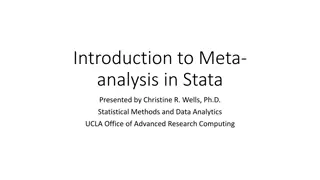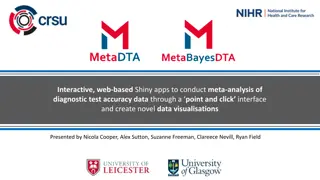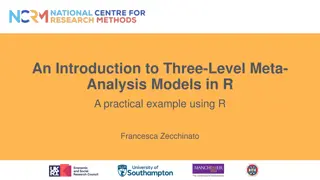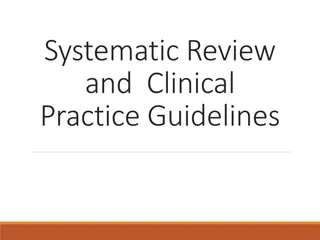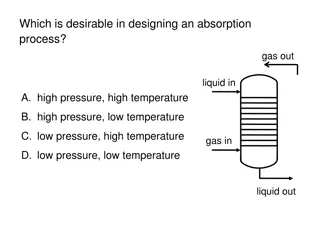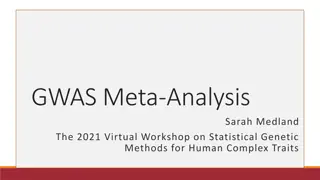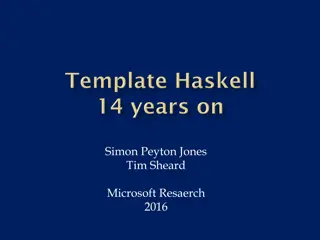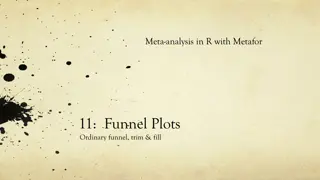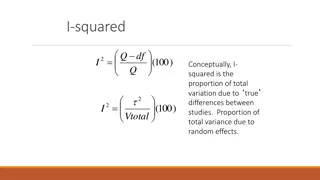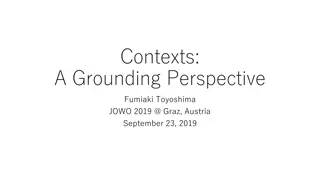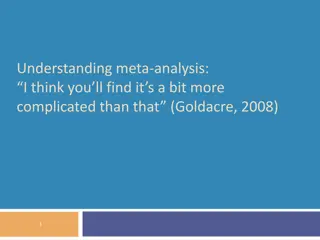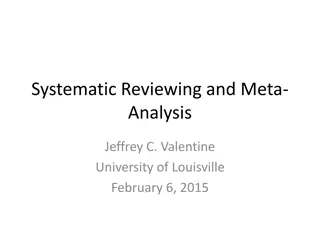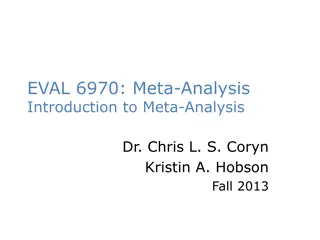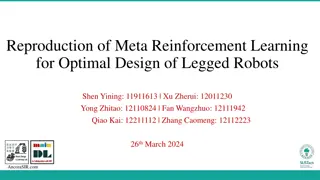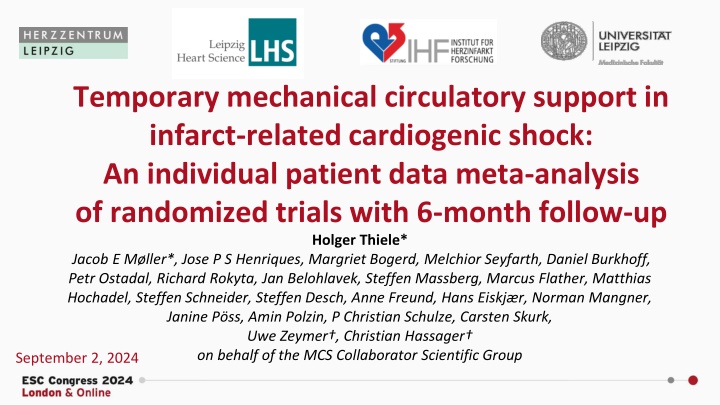
Temporary Mechanical Circulatory Support in Cardiogenic Shock Meta-Analysis
Explore a comprehensive meta-analysis of randomized trials on temporary mechanical circulatory support in cardiogenic shock post heart attack. Delve into the nuances of patient data, treatment biases, and trial results to gain insights into device efficacy and patient selection.
Download Presentation

Please find below an Image/Link to download the presentation.
The content on the website is provided AS IS for your information and personal use only. It may not be sold, licensed, or shared on other websites without obtaining consent from the author. If you encounter any issues during the download, it is possible that the publisher has removed the file from their server.
You are allowed to download the files provided on this website for personal or commercial use, subject to the condition that they are used lawfully. All files are the property of their respective owners.
The content on the website is provided AS IS for your information and personal use only. It may not be sold, licensed, or shared on other websites without obtaining consent from the author.
E N D
Presentation Transcript
Temporary mechanical circulatory support in infarct-related cardiogenic shock: An individual patient data meta-analysis of randomized trials with 6-month follow-up Holger Thiele* Jacob E M ller*, Jose P S Henriques, Margriet Bogerd, Melchior Seyfarth, Daniel Burkhoff, Petr Ostadal, Richard Rokyta, Jan Belohlavek, Steffen Massberg, Marcus Flather, Matthias Hochadel, Steffen Schneider, Steffen Desch, Anne Freund, Hans Eiskj r, Norman Mangner, Janine P ss, Amin Polzin, P Christian Schulze, Carsten Skurk, Uwe Zeymer , Christian Hassager on behalf of the MCS Collaborator Scientific Group September 2, 2024
Conflict of Interest Statement Funding: German Research Foundation German Heart Research Foundation German Cardiac Society European Union Else-Kr ner-Fresenius-Foundation Schwiete-Foundation Boston Scientific Heart Center Leipzig Institut f r Herzinfarktforschung Consulting: None Speaker Honoraria: None
Background Currently Available MCS 2.5 CP 5.0 5.5 5 Unloading Loading Thiele et al. Eur Heart J 2019:40:2671-2683 Byrne et al. Eur Heart J 2023;44: 3720 3826
Background Different Trial Results 58.5% 45.8% Thiele et al. NEJM 2023; 389:1286-1297 M ller et al. NEJM 2024;390:1382-1393
How Can these Differences Be Explained? Background LV Unloading Device? LV Loading STEMI + NSTEMI 77% Resuscitation -> 20% hypoxic brain injury Lactate 6.9 mmol/l Ventilation: 90% Catecholamines: 90% STEMI only 20% Resuscitation - only witnessed CA -> 2% hypoxic brain injury Lactate 4.5 mmol/l Ventilation: 70% Catecholamines: 85% Patient selection? Follow-up? 30 days 6 months RRT 8.1% vs 13.1% ICU time: 10 vs 8 days MCS duration: 2.7 days RRT 41.9% vs 26.7% ICU time: 6 vs 3 days MCS duration: 2.5 days Treatment Bias? Thiele et al. NEJM 2023; 389:1286-1297 M ller et al. NEJM 2024;390:1382-1393
Aims and Methods To overcome current insufficient evidence related to MCS device and patient selection in the treatment of cardiogenic shock complicating AMI, we performed a collaborative meta-analysis of ALL RCTs using 1) individual patient data 2) including unpublished data with longer 6-month follow-up. This study is registered with PROSPERO (CRD42024504295).
Aims and Methods Three major analyses were performed to ascertain the effects on 6-month mortality of 1) Early routine active MCS versus control (incl. IABP) 2) Focus on device type, i.e. a) loading MCS (VA-ECMO) versus control and b) unloading MCS (Impella/TandemHeart) vs control 3) Focus on patient selection, i.e., MCS versus control in DanGer- like patients (STEMI without risk of hypoxic brain injury).
Methods Search Strategy
Baseline Characteristics TOTAL 1059 (100.0%) Results MCS Control 526 (49.7%) Patients included Demographics Age (years); Median (IQR) Male sex Cardiovascular risk factors Current smoking Hypertension Dyslipidemia Diabetes mellitus Baseline hemodynamics Systolic BP [mmHg] Mean BP [mmHg] ECG pre PCI ST-segment elevation NSTEMI Anterior infarction Resuscitation prior rando No. of diseased vessels Single vessel disease Double vessel disease Triple vessel disease Baseline LVEF [%] Baseline laboratory values Pre-PCI Lactate Lactate 5 mmol/l GFR [ml/min] 533 (50.3%) 65 (57;73), N=1058 845/1058 (79.9%) 64 (57;72), N=532 421/532 (79.1%) 66 (58;73), N=526 424/526 (80.6%) 364/976 (37.3%) 573/1020 (56.2%) 331/930 (35.6%) 292/1024 (29.0%) 185/486 (38.1%) 283/513 (55.2%) 150/465 (32.3%) 144/514 (28.0%) 179/490 (36.5%) 290/507 (57.2%) 181/465 (38.9%) 148/510 (29.0%) 92 26, N=896 70 19, N=959 92 25, N=457 69 18, N=488 93 27, N=439 70 20, N=471 819/1008 (81.3%) 189/1008 (18.8%) 644/997 (64.6%) 534/1037 (51.5%) 412/504 (81.7%) 92/504 (18.3%) 323/502 (64.3%) 272/521 (52.2%) 407/504 (80.8%) 97/504 (19.2%) 321/495 (64.9%) 262/516 (50.8%) 306/1013 (30.2%) 317/1013 (31.3%) 366/1013 (36.1%) 25 (20;35), N=857 165/508 (32.5%) 174/508 (34.3%) 158/508 (31.1%) 25 (20;35), N=422 141/505 (27.9%) 143/505 (28.3%) 208/505 (41.2%) 27 (20;35), N=435 5.6 (3.7;9.0), N=1020 576/1020 (56.5%) 64.3 (47.5, 84.3), N=640 5.6 (3.7;8.5), N=512 291/512 (56.8%) 65.8 (47.5, 84.2), N=318 5.6 (3.7;9.5), N=508 285/508 (56.1%) 63.0 (47.5, 84.3), N=322
Treatment Results TOTAL MCS Control Type of revascularisation Initial revascularisation by PCI only Initial revascularisation by CABG PCI with immediate transfer to CABG No revascularisation TIMI flow before revascularisation TIMI-flow 0 TIMI-flow I TIMI-flow II TIMI-flow III TIMI flow after revascularisation TIMI-flow 0 TIMI-flow I TIMI-flow II TIMI-flow III Immediate multivessel-PCI Circulatory support Device randomized to Standard care including IABP VA-ECMO TandemHeart Impella 2.5 Impella CP Other treatment Mechanical ventilation Duration, Median (IQR) 994/1044 (95.2%) 3/1044 (0.3%) 11/1044 (1.1%) 36/1044 (3.4%) 499/526 (94.9%) 1/526 (0.2%) 5/526 (1.0%) 21/526 (4.0%) 495/518 (95.6%) 2/518 (0.4%) 6/518 (1.2%) 15/518 (2.9%) 586/998 (58.7%) 136/998 (13.6%) 151/998 (15.1%) 125/998 (12.5%) 286/502 (57.0%) 74/502 (14.7%) 76/502 (15.1%) 66/502 (13.1%) 300/496 (60.5%) 62/496 (12.5%) 75/496 (15.1%) 59/496 (11.9%) 24/978 (2.4%) 30/978 (3.1%) 115/978 (11.8%) 809/978 (82.6%) 74/546 (13.6%) 14/489 (2.9%) 17/489 (3.5%) 51/489 (10.4%) 407/489 (83.2%) 42/273 (15.4%) 10/489 (2.0%) 13/489 (2.7%) 64/489 (13.1%) 402/489 (82.2%) 32/273 (11.7%) 526/1059 (49.7%) 284/1059 (26.8%) 33/1059 (3.1%) 13/1059 (1.2%) 203/1059 (19.2%) 0/533 (0%) 284/533 (53.3%) 33/533 (6.2%) 13/533 (2.4%) 203/533 (38.1%) 526/526 (100 0%) 0/526 (0%) 0/526 (0%) 0/526 (0%) 0/526 (0%) 859/1018 (84.4%) 5.0 (2.3;10.0) 441/510 (86.5%) 6.0 (3.0;11.0) 418/508 (82.3%) 5.0 (2.0;8.3)
Results 6-Month Mortality - MCS versus no MCS
Results 6-Month Mortality Loading Devices (VA-ECMO) versus no MCS
Results 6-Month Mortality Unloading (Impella/TandemHeart) versus no MCS
Results 6-Month Mortality Patient Selection MCS versus no MCS
Results Forest Plot 6-Month Mortality
Results Subgroup Analysis
Results Secondary Endpoints + Safety @30 Days HR 0.89 (0.74 1.06) 47.1 50 45 43.6 40 OR 2.64 (1.91 3.65) 35 28.3 30 OR 1.29 24.0 (0.94 1.77) 25 20.3 OR 1.28 (0.87 1.88) % 16.7 20 13.3 13.3 15 OR 4.43 (2.37 8.26) 9.7 10 OR 1.48 (0.72 3.04) 3.8 2.6 2.3 5 0 MCS Control
Summary and Conclusions In patients with acute myocardial infarction and cardiogenic shock with planned revascularization routine early MCS versus control does not reduce 6-month all- cause mortality. This lack of 6-month mortality benefit is irrespective of the device type; i.e. loading versus unloading devices. MCS use is associated with an increased risk of bleeding and peripheral vascular complications. A benefit of early MCS on 6-month mortality was observed only for patients with STEMI and low risk of hypoxic brain injury. Therefore, MCS should only be reserved for selected patients.
Acknowledgments and Thank You Funding Our greatest thanks go to the patients and relatives. Thank you to all investigators of the inidividial RCTs @thiele_holger holger.thiele@medizin.uni-leipzig.de
Now Online www.thelancet.com

